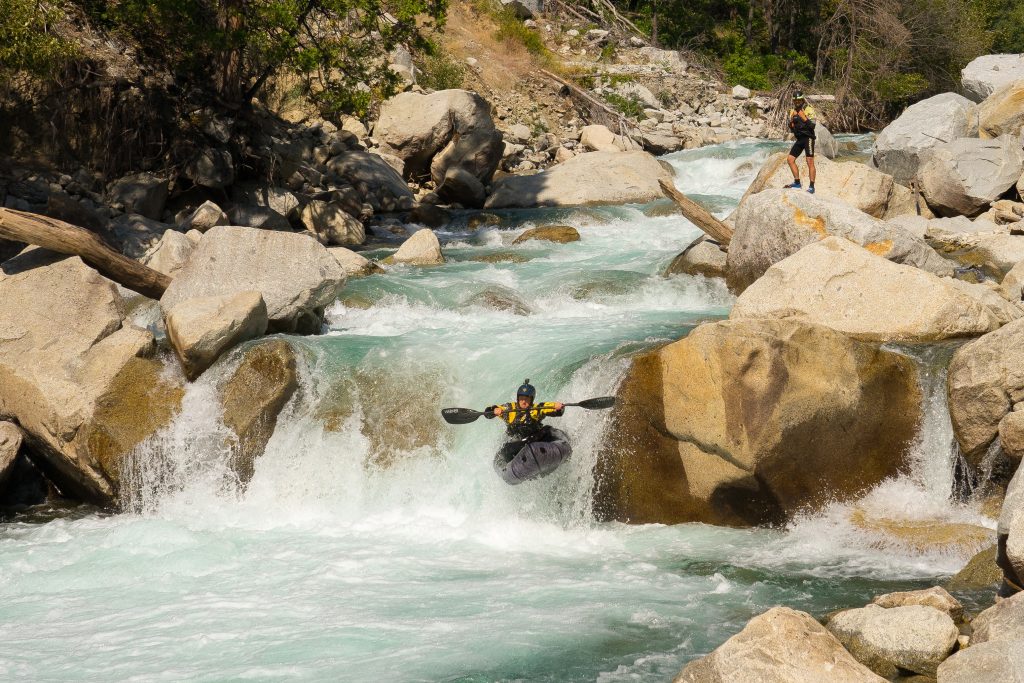
Photos Daniel Thurber
It’s my first day of the 2019 season wearing a full pack. The hip belt is wearing a hole straight through my back. As we approach the overlook, the discomfort is easily overshadowed by anticipation, excitement, and foreboding. I’ve been imagining this trip for years and spent most of the last summer questioning the wisdom of taking an inflatable packraft to a river that is routinely heralded as the pinnacle of Class V+ expedition kayaking in North America. This would not be a question to most people, just a horrible idea. We set our packs down at the overlook for a quick snack, gazing down into Tehipite Valley, then began the arduous descent to the Middle Fork of the Kings River.
The Middle Kings had seen a first descent in 1982 by a group of adventurers far more hardy than ourselves. Their tales of portaging steep boulder gardens, slides, gorges, and waterfalls kept other groups from attempting the run for 13 years. As boats, athletes, and beta improved through the last two decades, the Middle Kings grew to astronomical prestige among kayakers. Kayakers. Conventional wisdom was clear that a river dropping 7,000 feet in 36 miles was no place for packrafts. Then again, we had disrupted conventional wisdom several times before. Answering these questions is the essence of progression. Trudging down the steep trail to the bottom of the valley, I couldn’t shake the feeling that we might be finally pushing too far.
The truth is, my paddling career had been in a gradual decline for several years. After over a decade of West Coast tours, international expeditions, coaching on Class V, and exploratory missions, I pursued a lifestyle change and move that compromised my access to year-round kayaking. Adopting an athletic mutt meant I spent far more time taking him mountain biking than finding a new Class V crew and arranging road trips. I was fine with that. I needed to take things down a notch and re-evaluate my relationship with risk. Three days before moving from Idaho to Durango, CO, I had decided to give myself a proper send-off with one last top-to-bottom on the North Fork. It backfired with a rough line in Jake’s, and I found myself upside-down four times. Each time, I rolled up just in time to drift over a rocky drop that could have added me to the North Fork body count with slightly different luck. Finding new challenges in kayaking seemed to come with horrifying consequences, and my fire smoldered.
Tehipite Valley usually is a halfway point for kayak teams running the Middle Kings. The standard approach first reaches the river more than 20 miles upstream. We put together a different route that would enable bail-out options, a simpler shuttle, and the chance to see what we were getting into as we hiked up the river trail. After all, it was a river none of us had seen before. That style of trip, with no first-hand experience for the entire crew, is a special experience I frequently seek out. Our route came with a substantially longer hike, but with boats that weighed around 10 pounds and fit inside our packs, the extra output seemed tolerable. The wilderness permit was easier to secure. Besides, it meant we could stash a food resupply with a few treats in the Valley for night four. The next day of hiking would give us another chance to ponder our ambition for this coveted river.
·····
The water cycle provides an awkward narrative to the paddling season in Idaho and Colorado. The snow melts, rivers rise, and water levels are high by the time you can access the put-in. So, you recall the last time you paddled your local run. It went so well! Great lines! You’re such an athlete! Go for it again! But off the couch, your arms and core are atrophied from a winter of skiing. That move that should be so easy just….isn’t. The river humbles you. You decide to step back for a while, and towards the end of the season, as water levels recede, you are starting to get in better shape and back on the horse. You take a few runs on that local challenge and remember the last lap in particular; it went so well! You’re such an athlete! You’re ready for high water next year! Rinse and repeat. Such was the downward spiral of my identity as a Class V paddler. This was clearly unsustainable, and I began to ask myself: As I age, how must my expectations and aspirations change so my passion can be a lifelong sport?
Somewhere along the way, I met Jeff Creamer. We skied and biked together, but he didn’t kayak. Maybe worse, he was a packrafter. He wasn’t a great paddler, swam often, showed up to manky runs wearing knee pads, and regularly pursued remote runs solo because he couldn’t find a partner. Something told him I might be an easy target. One way or another, he convinced me to give packrafts a shot. First on the Arkansas River. Playboating at the town park. A proper expedition hiking in and out of Cataract Canyon. I was intrigued, but it was taking the packraft to a celebrated kayaking classic that really got me hooked.
I had heard some tales of people taking packrafts down hard runs. It sounded like a dumb stunt. I felt the same way when I first launched a borrowed packraft on Class V Vallecito Creek, which I knew well from a rigid cockpit. I thought it was a terrible idea that would end with a scary hike out in the dark. Jeff and I brought headlamps. We plopped over the warm-up drops and scouted Entrance Falls: a 17-foot waterfall with a tricky lead-in and caves on both sides of the landing that many experienced kayakers have swam out of. I gradually built up the nerves to give ‘er and momentarily ignored the absurdity of my craft decision. I made the familiar strokes, let the water drag me to the lip, and waited to time my stroke. I treated the boat like a kayak, and much to my amazement, it behaved accordingly. Halfway down the falls, I was still perfectly flat. I crunched up and landed on the boil with a firm slap, skipping away from the caves with a dry head and surprised grin. We continued through Trash Can, No Way Out, and every other intimidating Class V drop on the legendary creek. In one of the smaller rapids, I flipped over. I rolled up. By the time we cleared Finish Line, I wanted another lap.
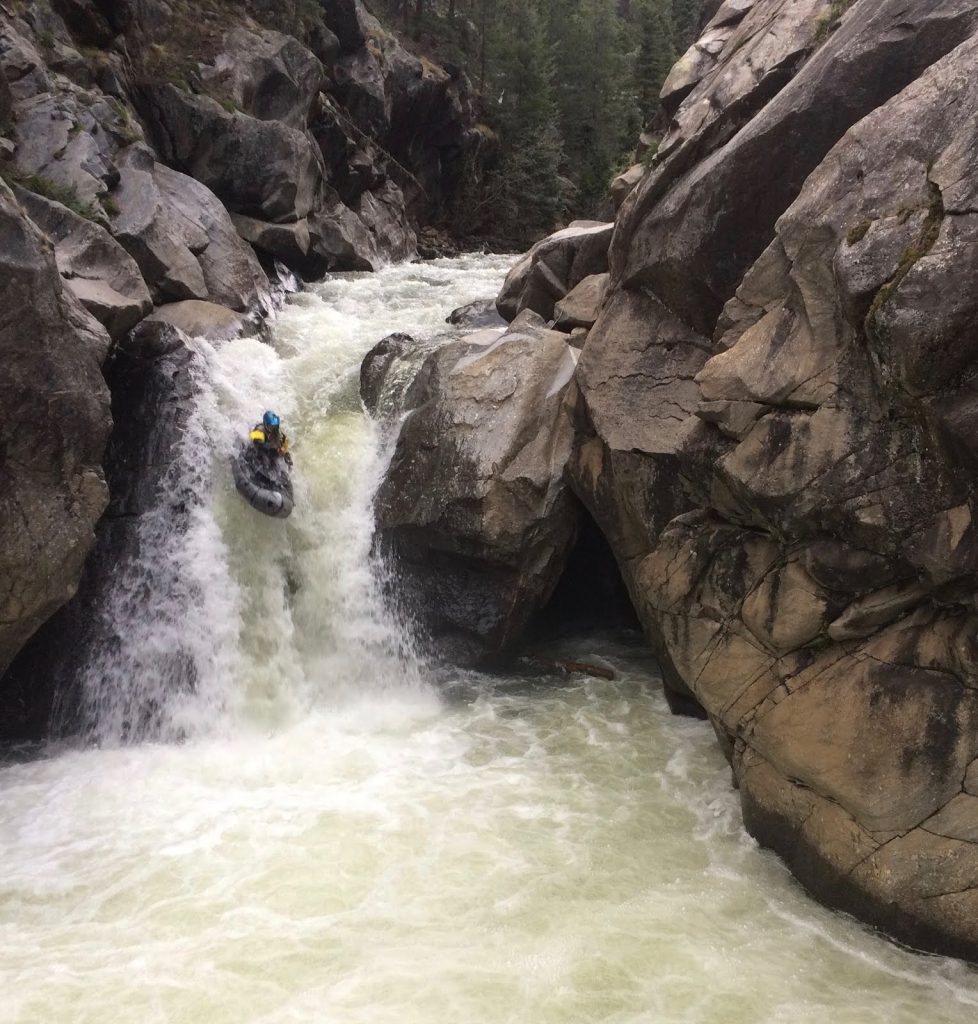
Photo Daniel Thurber
In the years that followed, Jeff poured his intense focus into paddling. He improved dramatically, dialing in his surfs, boofs, and roll. While I had a leg up in paddling experience, Jeff could travel through the backcountry on a level I had never seen. The two of us began teaming up with John Baker, another local kayaker with the packrafting bug, to think about some bigger objectives. We called ourselves the Ducky Buddies.
·····
Day two of hiking to the Middle Kings had us on a trail along the river. We could often see the rapids below us and began to feel some relief as much of it looked delightful. This optimism came with the footnote that the hardest section was further downstream in a canyon too rugged for a trail. Therefore, we were most intimidated by what we couldn’t see. To most, the challenge of kayaking the Middle Kings culminates downstream in the “Bottom Nine,” where the river paradoxically steepens with its peak flow for a nine-mile finale. One friend warned us before the trip, “You guys could probably packraft the Middle Kings. Well, mostly. Not the Bottom Nine. It’s too intense. You won’t survive.”
Much more of the hard whitewater was hidden in tight committing gorges. We trudged up the river canyon for another 17 miles, each thinking about how many of the big slides, waterfalls, and boulder gardens we might decide to take a shot at. After a full day on the trail, we made camp on a barren granite ledge surrounded by craggy ridge lines at the lip of such a slide. Still short of our intended launch site, we decided to rise early and hike the last mile with empty boats.
We were finally there by 10 a.m. the next day, launching on The Middle Kings—a river I had always considered out of my league. The stomping grounds of world-class adventure athletes, pro kayakers, and now…packrafters? We were already behind schedule. We bumped down easier ledges to the lips of the bigger drops celebrated on social media. Some of them we ran, others we walked. That’s how paddling works in the High Sierra.
In 2019, we were paddling a niche whitewater-focused packraft model called the Alpackalypse. Cutting edge at the time, our boats featured internal storage, decks with spray skirts, and secure outfitting. They still lacked the displacement hull, narrow tubes, and refined rocker profile of the modern Valkyrie, a true inflatable creekboat. Those features would develop, along with us, over the following five years. But the now-antiquated design of the Alpackalypse meant substantial compromises in boat performance and required adjustments to our paddling techniques and line selection.
The top of the Middle Kings is known for natural slides, where the river fans out in a thin film over sloped granite ledges. A plastic kayak will slide right across the surface, gaining speed and skipping across the pool below. This is a reason for the river’s acclaim. But a planing-hulled inflatable can warp to the shape of the rock and stick like a suction cup. If the slide is not steep enough or the water too shallow, we would awkwardly grind our way down and get stopped by the hydraulic at the bottom. And this was the easy stuff.
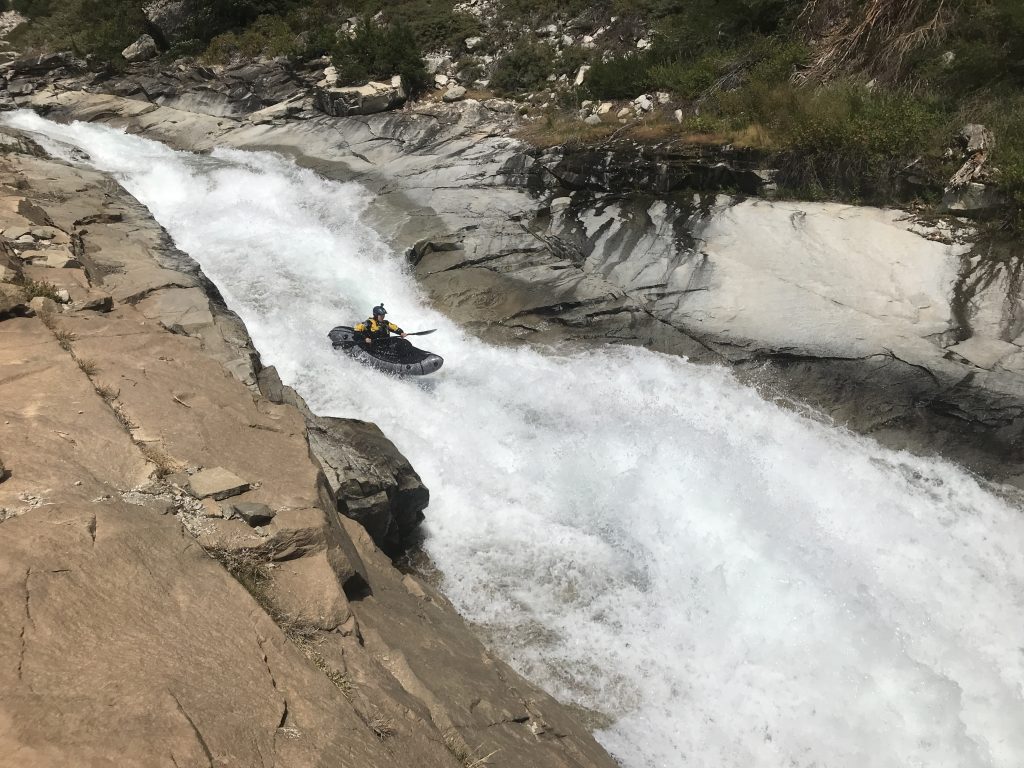
Photo Jeffrey Creamer
With heavy hearts, we portaged Money Drop, one of the most iconic waterfalls in California. The standard line looked great for a hardshell, but an inflatable would have to take a different route with a fair chance to flip before violently tumbling over the rocky lower falls. What were we doing here? Had we really come all this way just to walk around some of the best whitewater in the world? We became impatient and pushed our limits, but the river pushed back hard. Within the first mile or two, each of us had swum and deliberately recalibrated our risk thresholds.
·····
Packrafter. As my days in a ducky exceeded my days in a hardshell, the label began to stick. A few of my new paddling partners showed intrigue and offered accolades. Others quit calling me with invitations to paddle. When I was in a packraft on a day the purist kayakers were on the same river, I felt discarded from the community. They’d wish me luck and paddle away. I began to feel shame over the label. I chose to keep quiet about packrafting when talking to some of my dearest friends about my exploits and ambitions for fear they might sideline me as well. In conversations with a long-time teammate before embarking on one of the most intimidating expeditions of my life in Wyoming, I carefully hid the fact that I’d be paddling an inflatable boat down Bull Lake Creek instead of a long hike with a kayak like everyone before us.
Our 2018 descent of Bull Lake Creek, including an exploratory add-on, went off without a hitch. It was a pivotal awakening for our whole team and marked a milestone in our packrafting progression. We could run a creek described as a class V+ wilderness expedition that, at the time, would go years without seeing a kayak descent. That trip begged the question: what next? All three of us had uncertainties in our futures, but none of us could deny the allure of the Middle Kings. It is a river so steeped in lore that it seemed out of reach. Then again, our reach kept growing. We spent the next spring gradually rising from a deep winter with scenic rivers in the nearby Utah desert and laps down our familiar runs. Our conversation about new objectives featured many possibilities, but the Kings would often evade the discussion as though everyone was thinking it, but none wanted the burden of it being their idea.
·····
John Baker was the strongest paddler in our group. I was typically more conservative and if John ever chose to portage a rapid, I almost certainly walked. Shortly below Money Drop, we came to a long complex rapid that only he had the nerve to run. He was pushed off line and swam in a hole. We roped him out after some unpleasant downtime. Immediately, his fire seemed to die. John took to portaging more often and was no longer the barometer I had grown used to. At the top of our first gorge, I turned to Jeff. John had chosen to portage the gorge. I was ready to follow when Jeff showed some optimism.
Below us were a half-dozen drops that all formed powerful holes. Each of them could dish a beatdown in a tight gorge with no escape, aside from the 20-foot waterfall at the downstream exit. Jeff saw that every drop also had its own weakness. A tongue here, a curler there. Right, right, left. Center and left again. Keep the bow up over the holes. Thread the needle through a deep channel, and line up the slide. Move right and drive into the eddy. Jeff and I scouted and scouted again. We discussed the moves until we both memorized the sequence and agreed that it could be done. The imaginative rehearsal paid off: Move after move, we stayed in control and on-line. Silently leapfrogging with eye contact, hand signals, and firm nods. The first eddy Jeff and I caught together was just upstream of the final falls. Jeff won the traditional ro-sham-bo above the lip, so I had to follow. Each in turn, we peeled out, gathered speed, and took a decisive stroke to sail into twenty feet of freefall. Finally, we could cleanly run a marquee section of the Middle Kings.
With the waterfall gorge behind us, we chose to portage the next section of river. Many kayakers make the same decision here and the need to prove ourselves to this mighty river was fading. We easily carried our boats along the trail, bypassing two more gorges. The distant rumble of water and rock validated our decision to walk until the gradient of the river subsided, the gorges yielded to the valley, and we could paddle a more accommodating river for miles to our camp for the night.
·····
The fourth day of our Kings trip was the first to feel normal. Our agenda for the day: paddle downstream. Run the rapids that look good; walk the ones that don’t. We were comfortably on schedule to reach our food cache that afternoon. Our view of the river valley from the overlook and the trail grade we had hiked substantiated that this section of the river would be steep, but we had seen a fair amount of it from the trail and were excited for what lay ahead. Rapids built up in difficulty through the morning, and we hit our stride of teamwork, with just one paddler scouting when reasonable and everyone taking a look when necessary. We portaged a few rapids and ran everything else. Some we ran twice. We set safety for each other, congratulated good lines, and rebuilt any confidence lost the day before. It felt like we deserved our place floating on this legendary river. Tehipite Valley opened up and welcomed us back to celebrate a beautiful day on the river. In a valley with the scale of Yosemite and not another human for miles, we recounted our successes from the day and recognized the hardest was yet to come.
·····
Jeff is a glutton for novel adventures with a twist. Every conversation, no matter the topic, eventually settles into a proposal for some route he has schemed up while pouring over topos on his kitchen table late at night. The spring of 2019 was no different, but I was starting to fixate on the Kings. Instead of spending our summer together on creative new expeditions, we each took to our own ways of preparing for our most ambitious whitewater challenge yet. John spent time with his family and conditioned on the local creeks. I went to Idaho to reclaim my identity as a big water kayaker and get stronger. I cautiously shared our interest in the Kings with close friends and mentors and was surprised to be met with universal encouragement. Jeff took off to tackle other High Sierra classics. Our target date for the Middle Kings drew closer. We carefully studied hydrographs and weather forecasts under the false pretense that we knew what ideal flows would be for us. True to form, Jeff devised an alternative route that no one had ever done, involving almost three times the trail mileage. After all the packing, planning, driving, and walking, we found ourselves at the edge of Tehipite Valley, looking down on the Everest of North American kayaking.
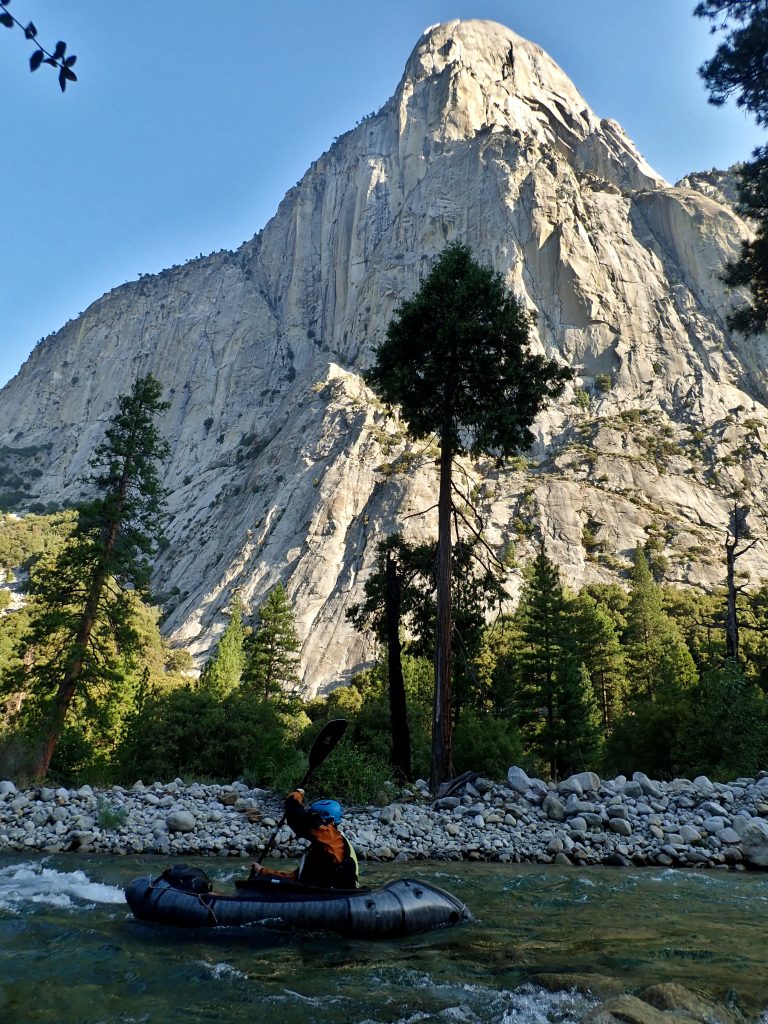
Photo Jeffrey Creamer
Four days later, we woke up early in that same valley. We quietly went about our morning rituals, loaded our boats, and pushed off. John, Jeff, and I were on the water an hour earlier than in previous days. No one knew exactly what to expect beyond stacked steep boulder gardens, hard portaging, and hopefully a few rapids we could run. After all, even elite kayakers portage in the Bottom Nine. The routine from the day before was automatic. We optimistically scouted from our boats when possible, but were quickly forced to look at most rapids from shore. Every 30 yards presented a new horizon line. A chaotic ten-footer with a sieve sent us on our first portage of the morning. A fast hallway led to a delightful, clean ledge. A double-drop offered a tricky but satisfying sequence of strokes. A maze of boulders formed a fast, fun sluice into a small eddy above another portage. The map showed continuous gradient all the way to the confluence, several miles downstream. We would run in two groups on some rapids to set safety and take photos. Eddy by eddy, rapid by rapid, we carefully worked our way through the Bottom Nine. We belonged there.
The number of runnable rapids stunned us as much as the relentless gradient. After several years of pushing ourselves in packrafts and the last two days as a team on this river, we approached hundreds of drops with confidence that we could run them with style. As the morning turned to afternoon, we became more comfortable with the consistent gradient and skills of our partners and ourselves. We would occasionally take turns scouting, trusting each other with verbal instructions. Spouts, ledges, curlers, and pour-overs offered smooth lines with smiles and high fives in the eddy at the bottom. Occasionally, the scout would look back at the others and make a walking gesture with his index and middle fingers. We portaged a dozen times as we progressed down the canyon. I tracked our position on GPS and consistently looked to distant ridgelines, curious if we could see the confluence. We focused on elevation to monitor our progress. It was slow. As a personal first descent for all of us, every corner commanded caution, and the Bottom Nine has lots of corners. A part of me was eager and anxious to have this section of river behind us. Then, after the sun went behind ridgelines, we finished a portage and arrived at the top of one of the most interesting and exhilarating sets of drops I’d ever paddled. A steep hallway between gargantuan boulders. Two drops in sequence with perfect curlers for 8-10 foot boofs. A slot to move to the other channel, with three more spouting drops before a deep pool full of high fives and hollering. By early evening, it was clear that we were paddling far more than we were walking, and when we decided to portage, we still had the strength and energy to jump from rock to rock. Pervasive traces of plastic on boulders suggested kayakers ahead of us had not enjoyed the same comfort.
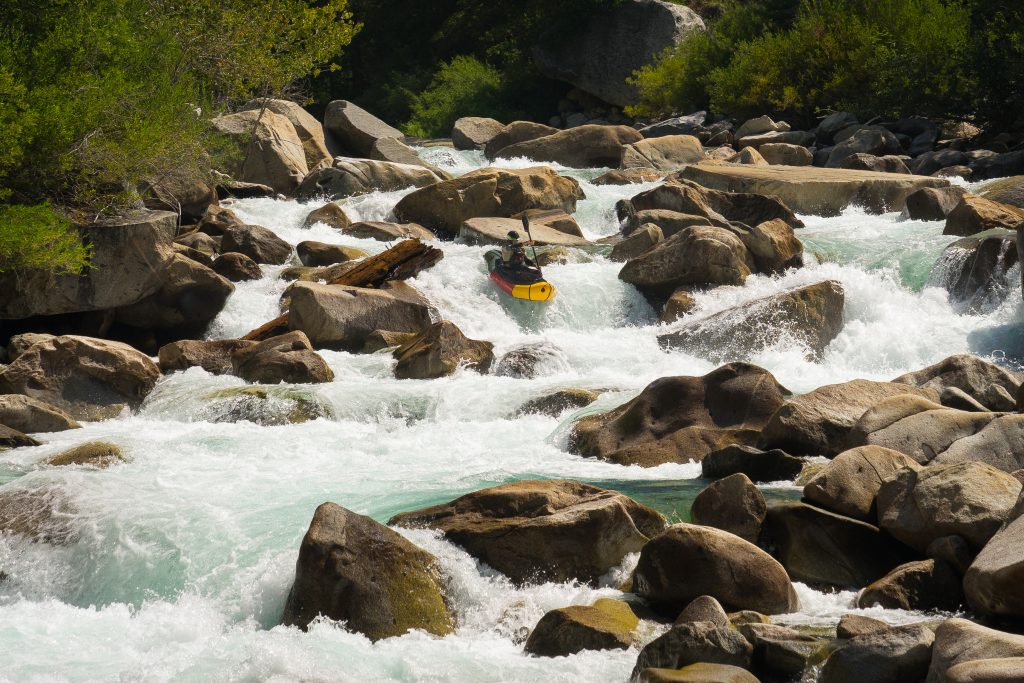
Photo John Baker
Despite a full-day effort, we fell short of completing the Bottom Nine. It was getting dark, and we found a nice camp while scouting a mile or two before the confluence. In the morning, we packed up quickly again and got going. This time, portaging was unnecessary. The gradient relaxed a little, and we picked our way downstream by eddy hopping with a few scouts. The ridge on the far side of the confluence came into view. A road cut across the hillside confirmed our progress. Our boats worked well, and our team worked better as we completed the final stretch of the canyon in the early morning light.
The sensation of arriving at the confluence was overwhelming. A decade prior, I had let this one go from my bucket list. The hiking, the weight, the whitewater, the portaging. The endurance. It was all out of my league. My self-doubt was further confirmed when my paddling reached an obvious decline. At thirty, I had peaked. A real job got in the way of big expeditions. Colorado’s seasonality interfered with consistent fitness. Like many of my mentors before me, I was looking back on the golden years: a time when I was skilled, driven, and racked up achievements worthy of respect. To continue pushing meant to put myself in more and more dangerous situations. I could always ask “what’s next?” but never liked the answer. One thing was certain, that I would never paddle the Middle Kings. Then we did.
The following summer, Dan and Jeff returned to complete their second descent of the Middle Kings with prototype boats that would evolve into the Alpacka Valkyrie. Together, they successfully ran Money Drop, Devil’s Washbowl, and dozens of rapids they had portaged on the first trip. Every season, they continue to pursue other remote and challenging rivers around the world.
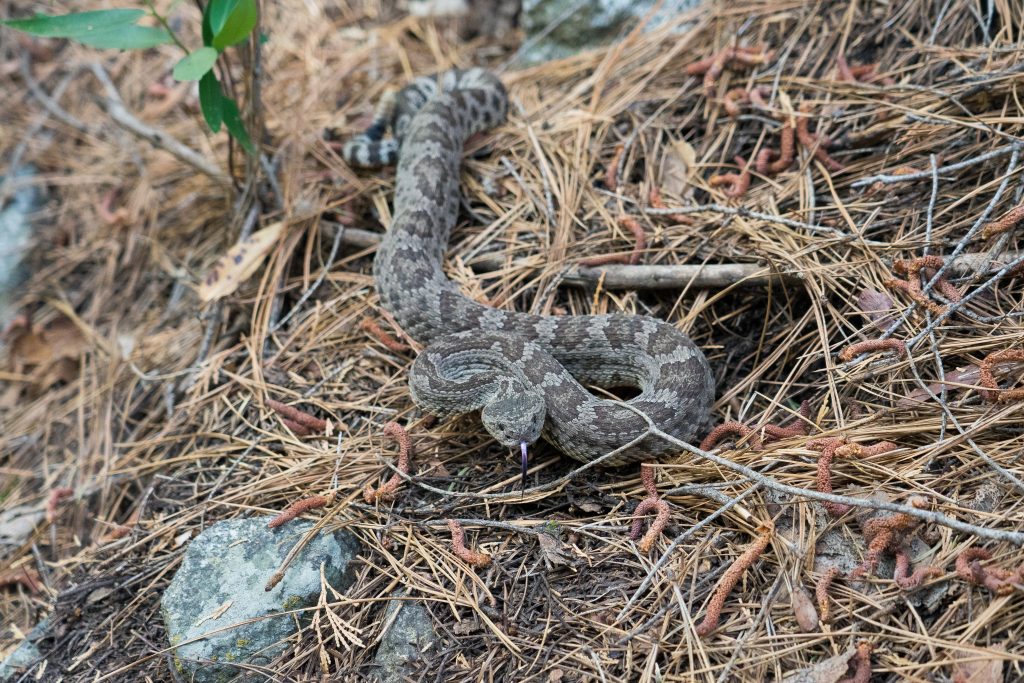
Leave a Reply